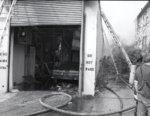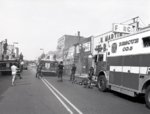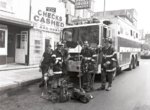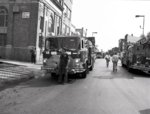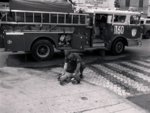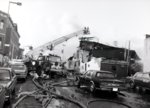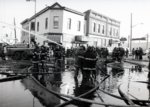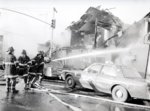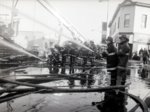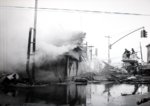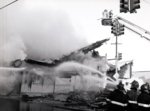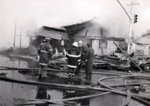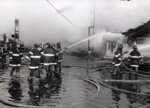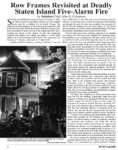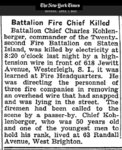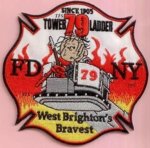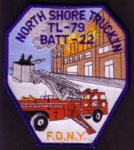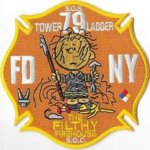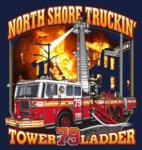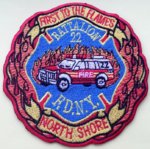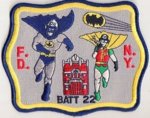You are using an out of date browser. It may not display this or other websites correctly.
You should upgrade or use an alternative browser.
You should upgrade or use an alternative browser.
FDNY and NYC Firehouses and Fire Companies - 2nd Section
- Thread starter mack
- Start date
Ladder 79/Battalion 22 (continued):
Ladder 79/Battalion 22 fire 2009:
Two Staten Island Brothers Killed, 9 Bravest Injured As House Consumed By Blaze
NY Daily News - January 10, 2009
by MIKE JACCARINO and TRACY CONNOR
Two Staten Island brothers were killed and nine firefighters were injured when a predawn inferno destroyed a home within minutes on Saturday morning.
"My boys are gone. My boys are gone," the victims' mother wept as she surveyed the charred hulk where her sons perished.
A fire official said the fast-moving blaze was "hot, smoky, dangerous, confusing and blinding" and left behind nothing but blackened debris.
"It's just madness inside," Lt. John Eccleston said after the flames were finally extinguished on Jewett Ave. in Port Richmond.
"It was the worst private dwelling fire I've seen in 25 years. We could see the glow from a half mile away." The cause of the 4:30 a.m. blaze was unknown and pinpointing it was difficult because the damage was so extensive.
Neighbors said the victims - whose names were not released - didn't have a chance if they were sleeping when the flames erupted.
"The whole front of the house was a complete fireball," said Billy Siverson, 47, who lives across the street on Jewett Ave.
"You couldn't get in there to save anyone. There was just way too much fire."
Tow truck driver Pete Puleo, 43, was driving down the street around 4:30 when he spotted the raging fire.
"It was like the movie 'Backdraft,'" he said. "Flames were double the size of the house. It was like planes had dropped bombs on top of the houses."
The fire quickly spread to adjacent two-story homes as firefighters ran down the street evacuating panicked residents.
"My 17-year-old kicked in my bedroom door at 4:40 and yelled, 'Fire! Everyone get out!'" said Christina Kramer, 46, whose house was damaged.
"I just grabbed my cat and my dog and my kids and got out..I thought I was having a heart attack.
"Everyone was screaming in the street because no one knew who had gotten in or out."
Nine firefighters suffered minor injuries.
"The firemen are OK," said Eccleston. "Let's just think about the victims right now."
A woman wrapped in a Red Cross blanket broke down at the scene, wailing, "My brothers! My brothers!"
The mother of the girlfriend of one of the victims said he had a 3-year-old son. "He loved his son so much," Gloria Amis said. "He was so happy to be a father."
Ladder 79/Battalion 22 fire 2009:
Two Staten Island Brothers Killed, 9 Bravest Injured As House Consumed By Blaze
NY Daily News - January 10, 2009
by MIKE JACCARINO and TRACY CONNOR
Two Staten Island brothers were killed and nine firefighters were injured when a predawn inferno destroyed a home within minutes on Saturday morning.
"My boys are gone. My boys are gone," the victims' mother wept as she surveyed the charred hulk where her sons perished.
A fire official said the fast-moving blaze was "hot, smoky, dangerous, confusing and blinding" and left behind nothing but blackened debris.
"It's just madness inside," Lt. John Eccleston said after the flames were finally extinguished on Jewett Ave. in Port Richmond.
"It was the worst private dwelling fire I've seen in 25 years. We could see the glow from a half mile away." The cause of the 4:30 a.m. blaze was unknown and pinpointing it was difficult because the damage was so extensive.
Neighbors said the victims - whose names were not released - didn't have a chance if they were sleeping when the flames erupted.
"The whole front of the house was a complete fireball," said Billy Siverson, 47, who lives across the street on Jewett Ave.
"You couldn't get in there to save anyone. There was just way too much fire."
Tow truck driver Pete Puleo, 43, was driving down the street around 4:30 when he spotted the raging fire.
"It was like the movie 'Backdraft,'" he said. "Flames were double the size of the house. It was like planes had dropped bombs on top of the houses."
The fire quickly spread to adjacent two-story homes as firefighters ran down the street evacuating panicked residents.
"My 17-year-old kicked in my bedroom door at 4:40 and yelled, 'Fire! Everyone get out!'" said Christina Kramer, 46, whose house was damaged.
"I just grabbed my cat and my dog and my kids and got out..I thought I was having a heart attack.
"Everyone was screaming in the street because no one knew who had gotten in or out."
Nine firefighters suffered minor injuries.
"The firemen are OK," said Eccleston. "Let's just think about the victims right now."
A woman wrapped in a Red Cross blanket broke down at the scene, wailing, "My brothers! My brothers!"
The mother of the girlfriend of one of the victims said he had a 3-year-old son. "He loved his son so much," Gloria Amis said. "He was so happy to be a father."
Ladder 79/Battalion 22 (continued):
Ladder 79 - Hero of the Month :
FDNY Lt. John Eccleston travels across U.S. to lend his expertise in a crisis
October 28, 2008 by nyredcross
Fire Lt. John Eccleston was in Mississippi for a week last month, after Hurricane Gustav hit, as a volunteer with the American Red Cross Disaster Assistance Response Team.
The DART team spent the time unloading trucks of supplies to stock warehouses in flooded areas.
“We usually load up a truck with food, water and supplies for repairs and go neighborhood to neighborhood and distribute them,” Eccleston said.
Gustav didn’t wreak the havoc that was predicted, so his team was sent home.
“Thank God, Hurricane Gustav wasn’t nearly as bad,” Eccleston said. “But I’m glad to be in a position to help.”
For 10 years, Eccleston, 50, has put himself in disaster spots all across the nation and in Puerto Rico, helping people re-cover from hurricanes, tornados and floods.
That’s aside from a 25-year career with the Fire Department.
“He is a model of volunteerism,” FDNY Chief Salvatore Cassano said.
For his tireless efforts and putting himself in harm’s way to help restore ruined lives, Eccleston is the Daily News Hero of the Month.
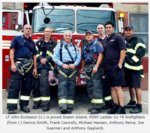
https://nyredcross.wordpress.com/20...-across-us-to-lend-his-expertise-in-a-crisis/
Ladder 79 - Hero of the Month :
FDNY Lt. John Eccleston travels across U.S. to lend his expertise in a crisis
October 28, 2008 by nyredcross
Fire Lt. John Eccleston was in Mississippi for a week last month, after Hurricane Gustav hit, as a volunteer with the American Red Cross Disaster Assistance Response Team.
The DART team spent the time unloading trucks of supplies to stock warehouses in flooded areas.
“We usually load up a truck with food, water and supplies for repairs and go neighborhood to neighborhood and distribute them,” Eccleston said.
Gustav didn’t wreak the havoc that was predicted, so his team was sent home.
“Thank God, Hurricane Gustav wasn’t nearly as bad,” Eccleston said. “But I’m glad to be in a position to help.”
For 10 years, Eccleston, 50, has put himself in disaster spots all across the nation and in Puerto Rico, helping people re-cover from hurricanes, tornados and floods.
That’s aside from a 25-year career with the Fire Department.
“He is a model of volunteerism,” FDNY Chief Salvatore Cassano said.
For his tireless efforts and putting himself in harm’s way to help restore ruined lives, Eccleston is the Daily News Hero of the Month.

https://nyredcross.wordpress.com/20...-across-us-to-lend-his-expertise-in-a-crisis/
- Joined
- Sep 25, 2013
- Messages
- 995
South Brooklyn, so named for being in the southern portion of the original City of Brooklyn and the Red Hook neighborhood, have had an organizational battalion presence from the inception of the Brooklyn Fire Department in 1869. Originally covered by the 1st District in Red Hook and the 2nd District in South Brooklyn, the presently similar Battalion 32 appeared in 1892 when most of the 1st District companies were moved into the newly organized 10th District, some of the 2nd District companies moved to the 1st District, and the 2nd District moved south and east of Downtown.
Upon merging with the FDNY in 1898, the 1st District became Battalion 2 of Brooklyn and Queens. Shortly thereafter, Battalion 2 was renumbered as Battalion 22 and then renumbered again as Battalion 32 in 1906.
The area has a wide range of challenges, including a container port, highway tunnel, industrial, warehouse, mercantile and residential occupancies, as well as supporting responses to high rise buildings in Lower Manhattan.
Upon merging with the FDNY in 1898, the 1st District became Battalion 2 of Brooklyn and Queens. Shortly thereafter, Battalion 2 was renumbered as Battalion 22 and then renumbered again as Battalion 32 in 1906.
The area has a wide range of challenges, including a container port, highway tunnel, industrial, warehouse, mercantile and residential occupancies, as well as supporting responses to high rise buildings in Lower Manhattan.
| Brooklyn FD | ||||
| District Engineer 1 | Organized | Van Brunt & Carroll Sts, Brooklyn | 1869 | with Brooklyn FD Engine 2 |
| District Engineer 1 | New Station | 199 Van Brunt St, Brooklyn | 1872 | with Brooklyn FD Engine 2 |
| District Engineer 1 | Relocated | 533 Hicks St, Brooklyn | 1896 | with Brooklyn FD Engine 3 |
| District Engineer 1 | Annexed | as Battalion 02 FDNY Brooklyn | 1898 | |
| FDNY Brooklyn | ||||
| Battalion 2 | Organized | 533 Hicks St, Brooklyn | 1898 | with Engine 3 FDNY Brooklyn, from Brooklyn FD District Engineer 1 |
| Battalion 2 | Renumbered | as Battalion 22 | 1898 | |
| FDNY Brooklyn | ||||
| Battalion 22 | Organized | 533 Hicks St, Brooklyn | 1898 | with Engine 3 FDNY Brooklyn, from Battalion 2 FDNY Brooklyn |
| Battalion 22 | Renumbered | as Battalion 32 | 1906 | |
| Battalion 32 | Reorganized | 533 Hicks St, Brooklyn | 1906 | with Engine 103, from Battalion 22 |
| Battalion 32 | Relocated | 199 Van Brunt St, Brooklyn | 1912 | with Engine 102 |
| Battalion 32 | Relocated | 533 Hicks St, Brooklyn | 1922 | with Engine 203 |
| Battalion 32 | Relocated | 299 Degraw St, Brooklyn | 1940 | with Engine 204 |
| Battalion 32 | Relocated | 533 Hicks St, Brooklyn | 1944 | with Engine 203 |
| Battalion 32 | Relocated | 31 Richards St, Brooklyn | 1974 | with Engine 202 |
| Battalion 32 | Temporary | 274 Hicks St, Brooklyn | 2016 | with Engine 224 |
| Battalion 32 | Renovated | 31 Richards St, Brooklyn | 2017 | with Engine 202 |
Last edited:
- Joined
- Sep 25, 2013
- Messages
- 995
Companies in Battalion 32South Brooklyn, so named for being in the southern portion of the original City of Brooklyn and the Red Hook neighborhood, have had an organizational battalion presence from the inception of the Brooklyn Fire Department in 1869. Originally covered by the 1st District in Red Hook and the 2nd District in South Brooklyn, the presently similar Battalion 32 appeared in 1892 when most of the 1st District companies were moved into the newly organized 10th District, some of the 2nd District companies moved to the 1st District, and the 2nd District moved south and east of Downtown.
Upon merging with the FDNY in 1898, the 1st District became Battalion 2 of Brooklyn and Queens. Shortly thereafter, Battalion 2 was renumbered as Battalion 22 and then renumbered again as Battalion 32 in 1906.
The area has a wide range of challenges, including a container port, highway tunnel, industrial, warehouse, mercantile and residential occupancies, as well as supporting responses to high rise buildings in Lower Manhattan.
Brooklyn FD District Engineer 1 Organized Van Brunt & Carroll Sts, Brooklyn 1869 with Brooklyn FD Engine 2 District Engineer 1 New Station 199 Van Brunt St, Brooklyn 1872 with Brooklyn FD Engine 2 District Engineer 1 Relocated 533 Hicks St, Brooklyn 1896 with Brooklyn FD Engine 3 District Engineer 1 Annexed as Battalion 02 FDNY Brooklyn 1898 FDNY Brooklyn Battalion 2 Organized 533 Hicks St, Brooklyn 1898 with Engine 3 FDNY Brooklyn, from Brooklyn FD District Engineer 1 Battalion 2 Renumbered as Battalion 22 1898 FDNY Brooklyn Battalion 22 Organized 533 Hicks St, Brooklyn 1898 with Engine 3 FDNY Brooklyn, from Battalion 2 FDNY Brooklyn Battalion 22 Renumbered as Battalion 32 1906 Battalion 32 Reorganized 533 Hicks St, Brooklyn 1906 with Engine 103, from Battalion 22 Battalion 32 Relocated 199 Van Brunt St, Brooklyn 1912 with Engine 102 Battalion 32 Relocated 533 Hicks St, Brooklyn 1922 with Engine 203 Battalion 32 Relocated 299 Degraw St, Brooklyn 1940 with Engine 204 Battalion 32 Relocated 533 Hicks St, Brooklyn 1944 with Engine 203 Battalion 32 Relocated 31 Richards St, Brooklyn 1974 with Engine 202 Battalion 32 Temporary 274 Hicks St, Brooklyn 2016 with Engine 224 Battalion 32 Renovated 31 Richards St, Brooklyn 2017 with Engine 202
| 1869 - 1886 | District Engineer 2 | E3 | E4 | E5 | ||||||
| 1886 - 1889 | District Engineer 2 | E3 | E4 | E5 | E23 | E24 | ||||
| 1889 - 1891 | District Engineer 2 | E3 | E4 | E5 | E24 | E26 | ||||
| 1891 - 1892 | District Engineer 2 | E3 | E4 | E5 | E24 | E26 | L10 | |||
| 1892 - 1896 | District Engineer 1 | E2 | E3 | E4 | L1 | |||||
| 1896 - 1898 | District Engineer 1 | E2 | E3 | E4 | E24 | L1 | ||||
| 1898 - 1900 | Battalion 22 | E2 | E3 | E4 | L1 | |||||
| 1900 - 1903 | Battalion 22 | E102 | E103 | E104 | L51 | |||||
| 1904 - 1906 | Battalion 22 | E102 | E103 | E104 | E124 | L51 | ||||
| 1906 - 1913 | Battalion 32 | E102 | E103 | E104 | E124 | L51 | ||||
| 1913 - 1915 | Battalion 32 | E202 | E203 | E204 | E224 | E279 | L101 | L131 | ||
| 1915 - 1917 | Battalion 32 | E202 | E203 | E204 | E279 | L101 | L131 | |||
| 1917 - 1918 | Battalion 32 | E202 | E203 | E204 | E279 | E279-2 | L101 | L131 | ||
| 1918 - 1922 | Battalion 32 | E202 | E203 | E204 | E279 | L101 | L131 | |||
| 1922 - 1941 | Battalion 32 | E202 | E203 | E204 | E279 | L101 | L110 | L131 | ||
| 1943 - 1945 | Battalion 32 | E202 | E203 | E204/S24 | E279 | L101 | L110 | L131 | ||
| 1945 - 1951 | Battalion 32 | E202 | E203 | E204 | E279 | L101 | L110 | L131 | ||
| 1951 - 1965 | Battalion 32 | E202 | E203 | E204 | E279 | L101 | L131 | |||
| 1965 - 1974 | Battalion 32 | E202 | E203 | E204 | E224 | E279 | L101 | L131 | ||
| 1974 - 1989 | Battalion 32 | E202 | E204 | E224 | E279 | L101 | L131 | |||
| 1989 - 2003 | Battalion 32 | E202 | E204 | E205 | E224 | E279 | L101 | L118 | L131 | |
| 2003 - | Battalion 32 | E202 | E205 | E224 | E279 | L101 | L118 | L131 |
Last edited:
Ladder 79/Battalion 22 (continued):
BC John Calderone - retirement:

NYC Fire Wire - July 12, 2016
We would like to congratulate Battalion Chief John Calderone who is working his last tour after 43 years with the FDNY. He is working today in the Field Comm Battalion (has for the past 6 months). Jack joined the FDNY September 1973, assigned to Eng.290. He was laid off in 1975, Came back to Eng.303, Lad.127 and Rescue 4. Promoted to Lt of HazMat, Squad 1 and Rescue 5. Promoted to Captain of Rescue 3, and again promoted to Battalion Chief in the 22. Jack is a very respected, decorated member of the FDNY, a firefighter we strive to be. He worked through the 'war years' of the FDNY and he saw the best and worst of NYC, and lost many friends on 9/11. He is also a well-known fire service author and has written extensive history on all types of FDNY apparatus makes and models.
He has certainly worked for that pension- we wish him the best in his 2nd life, retirement!
JOHN A. Q CALDERONE FF. LAD. 127 E-275 DEC. 18, 1977 1977 1978 STEUBEN
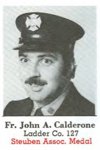
BC Calderone's books include:


BC John Calderone - retirement:

NYC Fire Wire - July 12, 2016
We would like to congratulate Battalion Chief John Calderone who is working his last tour after 43 years with the FDNY. He is working today in the Field Comm Battalion (has for the past 6 months). Jack joined the FDNY September 1973, assigned to Eng.290. He was laid off in 1975, Came back to Eng.303, Lad.127 and Rescue 4. Promoted to Lt of HazMat, Squad 1 and Rescue 5. Promoted to Captain of Rescue 3, and again promoted to Battalion Chief in the 22. Jack is a very respected, decorated member of the FDNY, a firefighter we strive to be. He worked through the 'war years' of the FDNY and he saw the best and worst of NYC, and lost many friends on 9/11. He is also a well-known fire service author and has written extensive history on all types of FDNY apparatus makes and models.
He has certainly worked for that pension- we wish him the best in his 2nd life, retirement!
JOHN A. Q CALDERONE FF. LAD. 127 E-275 DEC. 18, 1977 1977 1978 STEUBEN

BC Calderone's books include:

Last edited:
Ladder 79/Battalion 22 (continued):
Ladder 79 Medals:
FF John J. Drennan, July 8, 1976, awarded Delehanty Medal
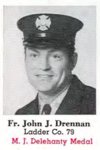

Capt. John J. Drennan - LODD - 62 Watts Street Fire 1994:

Talk of Life And Death Of Firefighter From Widow
By Robert D. McFadden May 9, 1994 NY Times
On a somber day of leaden skies and bittersweet remembrance, the widow of Capt. John J. Drennan stood in the portals of her husband's firehouse in SoHo yesterday and spoke quietly of the life and death of a firefighter, of courage and the limits of endurance in his 40-day ordeal with overwhelming burns.
"It's a good ending to a good life," Vina Drennan said of her husband's intense struggle for survival, which began March 28 with burns over 65 percent of his body in a blaze that killed two other firefighters and ended with his death on Saturday at the burn unit of New York Hospital-Cornell Medical Center.
Meantime, the surgeon who attended the 49-year-old Captain Drennan told in an interview of his patient's valiant fight for life through 10 skin graft operations, repeated infections, liver and kidney failures and other crises that he came close to outlasting, despite heavy odds against him.
And a fire captain who had been at the family's side virtually around the clock for nearly six weeks recounted an "emotional war" comparable to his own tour of military duty in Vietnam years ago: the honor of service, the daggers of frustration and the ultimate tragedy of defeat. 'He Loved Going to Work'
Solemn but tearless, her children beside her outside the firehouse at West Houston and the Avenue of the Americas, Mrs. Drennan's face was etched with the strain of the weeks at a hospital bedside as her husband endured his final days in interminable but dulled pain, motionless on his back and unable to speak.
"John Drennan had a wonderful life," said the widow, 48, a school teacher on Staten Island, where the family lives and where Captain Drennan had been a teacher and coach before joining the Fire Department. "He loved going to work every day -- 25 years he's enjoyed serving the people of the City of New York."
A funeral Mass for Captain Drennan, scheduled for St. Patrick's Cathedral at 10 A.M. on Wednesday, was expected to be attended by many of the city's 11,000 firefighters and top public officials, as well as thousands of firefighters from across the nation. The captain was the 756th New York City firefighter to die in the line of duty in the department's 129-year history.
Amid fire engines and ladders, floral bouquets left by neighborhood people and a yellow ribbon someone had tied to a tree, Mrs Drennan and her children -- Jessica, 25, Adrian, 24, Justine, 19, and John, 14 -- also paid tribute to the firefighters who had helped care for and comfort the captain and his family through the weeks of agonizing pain and emotional hardship.
"Many people have wondered how the Drennan family could be so strong," Mrs. Drennan said, "and this is the reason: these wonderful people have enveloped us with a lot of love and care and it's helped my children and myself get through a very big tragedy."
In the firehouse, the headquarters of Engine 24 and Ladder 5, the pictures of Captain Drennan and Firefighters James Young, 31, of Queens, and Christopher Siedenburg, 25, of Staten Island, who also
Queens, and Christopher Siedenburg, 25, of Staten Island, who also were killed in the explosive fire at 62 Watts Street in SoHo, had been posted in a window, and the mood was down.
A visibly shaken firefighter, Bob Callahan, said many young colleagues had looked upon Captain Drennan as a father figure. "A piece of each of us died with him," he said. "I'll never forget him."
Capt. Pat Brown, 41, who had known Captain Drennan for 15 years and had been assigned on the night of the fatal fire to aid Mrs. Drennan and her family during his hospitalization, told in another interview of a long vigil in hospital waiting rooms, in the patient's room and with family members at nearby accommodations supplied by the Fire Department.
"It was like an emotional war every day," said Captain Brown, who recalled a patient who breathed through a tube, was fed through a tube, could not talk, would lapse in and out of consciousness and, occasionally shed a tear as he endured crisis after crisis. "We planned his funeral three times," he added. "His heart couldn't take it any more. It's a miracle he survived this long."
Captain Brown said that, to spare him further agonies, Captain Drennan had never been told that two of his colleagues had also died as a result of burns in the Watts Street fire. "I just said to him, don't worry. Your wife and kids are doing fine and all the guys at the fire station are O.K. too."
Shaking his head at the memories, the captain added: "It was the hardest thing I've ever done. I was in Vietnam. I've spent 18 years as a firefighter. I've been in scores of tragedies. But this is by far the worst."
Dr. Michael Madden, clinical director of the burn unit at New York Hospital-Cornell Medical Center since 1981 and the surgeon who attended Captain Drennan, said yesterday that his patient had been up against terrible odds with third- and fourth-degree burns over 65 percent of his body, many of them not just through the skin but down into the muscle tissue and the bone.
Despite 10 operations ranging from 3 to 12 hours each to apply grafts of skin from Captain Drennan's chest, abdomen and scalp to the burned areas of his body -- his back and both sides from head to toe and his upper extremities as well -- the grafts were unable to establish much healthy new tissue, he said.
Captain Drennan endured many episodes of infection, the doctor said, in addition to liver and kidney failures.
"The amazing thing about it was that he began to recover, which is extremely unusual in burn patients who have multiple organ failure," Dr. Madden said. "Most people die. But his liver and kidneys were recovering. We were making progress covering his wounds and controlling the infections."
But around 4 A.M. on Saturday, there were signs of a new series of infections in his pancreas and in small areas throughout Captain Drennan's body, Dr. Madden said. The delicate balance between the invasion of bacteria and his body's defense mechanisms began to tip in favor of the bacteria, and he died at 4:47 P.M.
"His body had been running at full tilt for 40 days and 40 nights," he said referring to a metabolic rate of twice the normal levels. "At a certain point, you just can't keep it up. The infection outruns the defense mechanism, and that's what happened. The fact that he lasted for 40 days is a testament to his will to live and the fact that he was, without question, a fighter."
62 Watts Street Fire 1994:
http://www.fdnysbravest.com/Div7NewsletterJune2018.pdf
 firegroundleadership.com
firegroundleadership.com
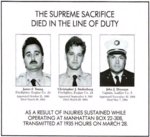
RIP. Never forget.
Ladder 79 Medals:
FF John J. Drennan, July 8, 1976, awarded Delehanty Medal


Capt. John J. Drennan - LODD - 62 Watts Street Fire 1994:

Talk of Life And Death Of Firefighter From Widow
By Robert D. McFadden May 9, 1994 NY Times
On a somber day of leaden skies and bittersweet remembrance, the widow of Capt. John J. Drennan stood in the portals of her husband's firehouse in SoHo yesterday and spoke quietly of the life and death of a firefighter, of courage and the limits of endurance in his 40-day ordeal with overwhelming burns.
"It's a good ending to a good life," Vina Drennan said of her husband's intense struggle for survival, which began March 28 with burns over 65 percent of his body in a blaze that killed two other firefighters and ended with his death on Saturday at the burn unit of New York Hospital-Cornell Medical Center.
Meantime, the surgeon who attended the 49-year-old Captain Drennan told in an interview of his patient's valiant fight for life through 10 skin graft operations, repeated infections, liver and kidney failures and other crises that he came close to outlasting, despite heavy odds against him.
And a fire captain who had been at the family's side virtually around the clock for nearly six weeks recounted an "emotional war" comparable to his own tour of military duty in Vietnam years ago: the honor of service, the daggers of frustration and the ultimate tragedy of defeat. 'He Loved Going to Work'
Solemn but tearless, her children beside her outside the firehouse at West Houston and the Avenue of the Americas, Mrs. Drennan's face was etched with the strain of the weeks at a hospital bedside as her husband endured his final days in interminable but dulled pain, motionless on his back and unable to speak.
"John Drennan had a wonderful life," said the widow, 48, a school teacher on Staten Island, where the family lives and where Captain Drennan had been a teacher and coach before joining the Fire Department. "He loved going to work every day -- 25 years he's enjoyed serving the people of the City of New York."
A funeral Mass for Captain Drennan, scheduled for St. Patrick's Cathedral at 10 A.M. on Wednesday, was expected to be attended by many of the city's 11,000 firefighters and top public officials, as well as thousands of firefighters from across the nation. The captain was the 756th New York City firefighter to die in the line of duty in the department's 129-year history.
Amid fire engines and ladders, floral bouquets left by neighborhood people and a yellow ribbon someone had tied to a tree, Mrs Drennan and her children -- Jessica, 25, Adrian, 24, Justine, 19, and John, 14 -- also paid tribute to the firefighters who had helped care for and comfort the captain and his family through the weeks of agonizing pain and emotional hardship.
"Many people have wondered how the Drennan family could be so strong," Mrs. Drennan said, "and this is the reason: these wonderful people have enveloped us with a lot of love and care and it's helped my children and myself get through a very big tragedy."
In the firehouse, the headquarters of Engine 24 and Ladder 5, the pictures of Captain Drennan and Firefighters James Young, 31, of Queens, and Christopher Siedenburg, 25, of Staten Island, who also
Queens, and Christopher Siedenburg, 25, of Staten Island, who also were killed in the explosive fire at 62 Watts Street in SoHo, had been posted in a window, and the mood was down.
A visibly shaken firefighter, Bob Callahan, said many young colleagues had looked upon Captain Drennan as a father figure. "A piece of each of us died with him," he said. "I'll never forget him."
Capt. Pat Brown, 41, who had known Captain Drennan for 15 years and had been assigned on the night of the fatal fire to aid Mrs. Drennan and her family during his hospitalization, told in another interview of a long vigil in hospital waiting rooms, in the patient's room and with family members at nearby accommodations supplied by the Fire Department.
"It was like an emotional war every day," said Captain Brown, who recalled a patient who breathed through a tube, was fed through a tube, could not talk, would lapse in and out of consciousness and, occasionally shed a tear as he endured crisis after crisis. "We planned his funeral three times," he added. "His heart couldn't take it any more. It's a miracle he survived this long."
Captain Brown said that, to spare him further agonies, Captain Drennan had never been told that two of his colleagues had also died as a result of burns in the Watts Street fire. "I just said to him, don't worry. Your wife and kids are doing fine and all the guys at the fire station are O.K. too."
Shaking his head at the memories, the captain added: "It was the hardest thing I've ever done. I was in Vietnam. I've spent 18 years as a firefighter. I've been in scores of tragedies. But this is by far the worst."
Dr. Michael Madden, clinical director of the burn unit at New York Hospital-Cornell Medical Center since 1981 and the surgeon who attended Captain Drennan, said yesterday that his patient had been up against terrible odds with third- and fourth-degree burns over 65 percent of his body, many of them not just through the skin but down into the muscle tissue and the bone.
Despite 10 operations ranging from 3 to 12 hours each to apply grafts of skin from Captain Drennan's chest, abdomen and scalp to the burned areas of his body -- his back and both sides from head to toe and his upper extremities as well -- the grafts were unable to establish much healthy new tissue, he said.
Captain Drennan endured many episodes of infection, the doctor said, in addition to liver and kidney failures.
"The amazing thing about it was that he began to recover, which is extremely unusual in burn patients who have multiple organ failure," Dr. Madden said. "Most people die. But his liver and kidneys were recovering. We were making progress covering his wounds and controlling the infections."
But around 4 A.M. on Saturday, there were signs of a new series of infections in his pancreas and in small areas throughout Captain Drennan's body, Dr. Madden said. The delicate balance between the invasion of bacteria and his body's defense mechanisms began to tip in favor of the bacteria, and he died at 4:47 P.M.
"His body had been running at full tilt for 40 days and 40 nights," he said referring to a metabolic rate of twice the normal levels. "At a certain point, you just can't keep it up. The infection outruns the defense mechanism, and that's what happened. The fact that he lasted for 40 days is a testament to his will to live and the fact that he was, without question, a fighter."
62 Watts Street Fire 1994:
http://www.fdnysbravest.com/Div7NewsletterJune2018.pdf
Lessons from the Fireground: Watts Street Fire-FDNY 1994 | Fireground Leadership
Operational Excellence on Today's Demanding Fireground

RIP. Never forget.
Last edited:
Ladder 79/Battalion 22 (continued):
Ladder 79 Medals:
LT James W. Fitzgerald, March 19, 1991, awarded Connell Medal
Lieutenant James W. Fitzgerald was awarded the Dr. John F. Connell Medal on March 19, 1991 for rescuing an eleven-month-old child.
LT Fred C. Zerilli, June 22, 1992, awarded FDR Medal
Lieutenant Fred C. Zerilli, who received the Ner Tamid Society/Franklin Delano Roosevelt Medal, rescued the same child Lt. Fitzgerald saved in 1991. Unfortunately, the 2-year-old did not survive his injuries.

FF John V. Picciano, July 21, 1993, awarded American Legion Medal
John V. Picciano rescued a woman from a burning second floor apartment on July 21, 1993. He received the American Legion/Mark M. Wohlfeld Memorial Medal.
FF Picciano commended for exceptional duty at 6 alarm brush fire in 2009:

Ladder 79 Medals:
LT James W. Fitzgerald, March 19, 1991, awarded Connell Medal
Lieutenant James W. Fitzgerald was awarded the Dr. John F. Connell Medal on March 19, 1991 for rescuing an eleven-month-old child.
LT Fred C. Zerilli, June 22, 1992, awarded FDR Medal
Lieutenant Fred C. Zerilli, who received the Ner Tamid Society/Franklin Delano Roosevelt Medal, rescued the same child Lt. Fitzgerald saved in 1991. Unfortunately, the 2-year-old did not survive his injuries.

FF John V. Picciano, July 21, 1993, awarded American Legion Medal
John V. Picciano rescued a woman from a burning second floor apartment on July 21, 1993. He received the American Legion/Mark M. Wohlfeld Memorial Medal.
FF Picciano commended for exceptional duty at 6 alarm brush fire in 2009:

Ladder 79/Battalion 22 (continued):
Ladder 79 medals:
FF Michael A. Pannell Ladder 79 2004 Connell Medal
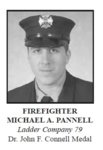
Bravest of the brave are honored
SI Advance - November 18, 2004
by JEFF HARRELL
He may have had less than a year on the job, but Firefighter Michael A. Pannell of Ladder Co. 79 in West Brighton showed the heroic instincts of a veteran by rescuing an unconscious victim from inside a burning building.
For his brave efforts on the morning of April 5, 2003, Pannell, 26, of Great Kills, was named Fire Officer of the Year during an awards ceremony co-sponsored by the Staten Island Chamber of Commerce and the Advance yesterday in Harbor Manor, located on the grounds of Snug Harbor Cultural Center, Livingston.
Fire Officer of the Year nominees Gary W. Persch and James M. McHale also were honored for freeing a construction worker who had been trapped in a collapsed trench.
Persch, 48, of Eltingville, a 17-year FDNY veteran assigned to Engine Co. 158 in Mariners Harbor, was awarded the Captain John J. Drennan Memorial Medal.
McHale, 38, of Willowbrook, a six-year FDNY veteran currently assigned to Ladder Co. 86 in Graniteville, took home the Firefighter Kevin C. Kane Medal.
'EXTRAORDINARY DEEDS'
"This means a great deal to members of their families," said FDNY Chief of Operations Sal Cassano, a Huguenot resident.
"These are ordinary people doing extraordinary deeds."
Along with Fire Officer of the Year honors, Pannell, a firefighter since July 2002, also received the Dr. John F. Connell Medal.
The rookie firefighter was working the night tour April 5 when a call came in shortly after 7 a.m. that a blaze had broken out on the second floor of a vacant commercial storefront at 1939 Richmond Terr. in Port Richmond. The building was known as a haven for the homeless.
Pannell and Firefighter Joseph Chin followed Lt. Thomas Costa into the building, but the ferocious flames and thick smoke made seeing anything nearly impossible. When Pannell and Chin entered a space being used as a bedroom, the intense heat forced Pannell to drop to the floor as he searched for victims.
Crawling, Pannell shone his flashlight on the face of an unconscious male. Pannell and Chin grabbed the victim, pulled him out of the room to the top of the stairs, and checked for vital signs. The victim seemed lifeless, but Pannell administered two quick rescue breaths before he and Chin removed the man from the building and turned him over to the waiting arms of EMS personnel.
The victim was taken to St. Vincent's Hospital, West Brighton, and treated for second- and third-degree burns over half his body, as well as severe smoke inhalation. He survived.
"You have to think," Pannell said yesterday, holding his Fire Officer of the Year award. "But this is something [a firefighter does] that comes naturally. You just react."
Persch and McHale were both on detail duty with West Brighton's Engine Co. 156 on Dec. 15 last year at about 3 p.m. when they responded to a report of a possible cardiac victim who had fallen into a hole on Taylor Street near DeGroot Place in West Brighton.
Upon arrival, the firefighters saw construction equipment near a trench, where they were met by two police officers who informed them that one construction worker was dead and another was trapped. Both victims, cops said, were working 15 feet down in a 30-foot-long trench when it partially collapsed and buried them.
BURIED UP TO CHEST
Persch and McHale used a ladder to climb down into the opening, braving dirt walls that were on the verge of further collapse. When they reached the surviving victim, a 66-year-old worker who was buried up to his chest in loose soil, the firefighters began digging feverishly with their hands and small shovels to free him.
The two firefighters also gave oxygen to the victim, who had inhaled a large amount of dust when the trench collapsed.
The man was treated at St. Vincent's Hospital.
McHale admitted to working on a "heavy adrenaline rush" whenever the alarm goes off and he responds to a call. Persch echoed Pannell's comments about "instinct" taking over during an emergency situation. "But you have to know what you're doing," Persch emphasized.
"We have a very talented workforce, which is exemplified by these three nominees," said Chief Thomas Haring, the Fire Department's borough commander.
"This is an excellent day for the Fire Department," Haring said. "And it's an excellent day for Staten Island."
https://www.ufanyc.org/cms/contents/view/3312
Ladder 79 medals:
FF Michael A. Pannell Ladder 79 2004 Connell Medal

Bravest of the brave are honored
SI Advance - November 18, 2004
by JEFF HARRELL
He may have had less than a year on the job, but Firefighter Michael A. Pannell of Ladder Co. 79 in West Brighton showed the heroic instincts of a veteran by rescuing an unconscious victim from inside a burning building.
For his brave efforts on the morning of April 5, 2003, Pannell, 26, of Great Kills, was named Fire Officer of the Year during an awards ceremony co-sponsored by the Staten Island Chamber of Commerce and the Advance yesterday in Harbor Manor, located on the grounds of Snug Harbor Cultural Center, Livingston.
Fire Officer of the Year nominees Gary W. Persch and James M. McHale also were honored for freeing a construction worker who had been trapped in a collapsed trench.
Persch, 48, of Eltingville, a 17-year FDNY veteran assigned to Engine Co. 158 in Mariners Harbor, was awarded the Captain John J. Drennan Memorial Medal.
McHale, 38, of Willowbrook, a six-year FDNY veteran currently assigned to Ladder Co. 86 in Graniteville, took home the Firefighter Kevin C. Kane Medal.
'EXTRAORDINARY DEEDS'
"This means a great deal to members of their families," said FDNY Chief of Operations Sal Cassano, a Huguenot resident.
"These are ordinary people doing extraordinary deeds."
Along with Fire Officer of the Year honors, Pannell, a firefighter since July 2002, also received the Dr. John F. Connell Medal.
The rookie firefighter was working the night tour April 5 when a call came in shortly after 7 a.m. that a blaze had broken out on the second floor of a vacant commercial storefront at 1939 Richmond Terr. in Port Richmond. The building was known as a haven for the homeless.
Pannell and Firefighter Joseph Chin followed Lt. Thomas Costa into the building, but the ferocious flames and thick smoke made seeing anything nearly impossible. When Pannell and Chin entered a space being used as a bedroom, the intense heat forced Pannell to drop to the floor as he searched for victims.
Crawling, Pannell shone his flashlight on the face of an unconscious male. Pannell and Chin grabbed the victim, pulled him out of the room to the top of the stairs, and checked for vital signs. The victim seemed lifeless, but Pannell administered two quick rescue breaths before he and Chin removed the man from the building and turned him over to the waiting arms of EMS personnel.
The victim was taken to St. Vincent's Hospital, West Brighton, and treated for second- and third-degree burns over half his body, as well as severe smoke inhalation. He survived.
"You have to think," Pannell said yesterday, holding his Fire Officer of the Year award. "But this is something [a firefighter does] that comes naturally. You just react."
Persch and McHale were both on detail duty with West Brighton's Engine Co. 156 on Dec. 15 last year at about 3 p.m. when they responded to a report of a possible cardiac victim who had fallen into a hole on Taylor Street near DeGroot Place in West Brighton.
Upon arrival, the firefighters saw construction equipment near a trench, where they were met by two police officers who informed them that one construction worker was dead and another was trapped. Both victims, cops said, were working 15 feet down in a 30-foot-long trench when it partially collapsed and buried them.
BURIED UP TO CHEST
Persch and McHale used a ladder to climb down into the opening, braving dirt walls that were on the verge of further collapse. When they reached the surviving victim, a 66-year-old worker who was buried up to his chest in loose soil, the firefighters began digging feverishly with their hands and small shovels to free him.
The two firefighters also gave oxygen to the victim, who had inhaled a large amount of dust when the trench collapsed.
The man was treated at St. Vincent's Hospital.
McHale admitted to working on a "heavy adrenaline rush" whenever the alarm goes off and he responds to a call. Persch echoed Pannell's comments about "instinct" taking over during an emergency situation. "But you have to know what you're doing," Persch emphasized.
"We have a very talented workforce, which is exemplified by these three nominees," said Chief Thomas Haring, the Fire Department's borough commander.
"This is an excellent day for the Fire Department," Haring said. "And it's an excellent day for Staten Island."
https://www.ufanyc.org/cms/contents/view/3312
Ladder 79/Battalion 22 (continued):
WTC LODD:
Francis Esposito Ladder 79 (working Engine 235) September 11, 2001
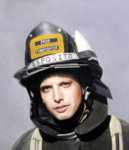


 www.silive.com
www.silive.com
WTC-Related Death:
BC Robert Miuccio Battalion 22 July 12, 2018
BC Miuccio died from WTC-related illness.
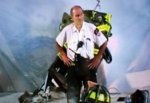
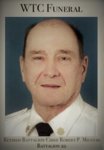
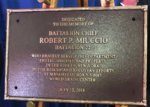

 www.silive.com
www.silive.com
RIP. Never forget.
WTC LODD:
Francis Esposito Ladder 79 (working Engine 235) September 11, 2001



Francis Esposito, 32, firefighter never froze under pressure
'He knew a lot about everything and there was nothing he was less than great at'
WTC-Related Death:
BC Robert Miuccio Battalion 22 July 12, 2018
BC Miuccio died from WTC-related illness.




FDNY remembers legacy of Staten Island hero who died of 9/11 cancer
Exactly one year after his death, Robert Miuccio was remembered on Friday with a commemorative plaque.
RIP. Never forget.
Last edited:
Ladder 79/Battalion 22 (continued):
West Brighton, Staten Island:
Originally called "Factoryville"


 en.wikipedia.org
en.wikipedia.org
http://forgotten-ny.com/2009/02/broadway-in-staten-island/
West Brighton, Staten Island:
Originally called "Factoryville"

Historic World Maps for Sale: Prints & Images: Historic Map Works, Residential Genealogy™
Historic Map Works is the world's largest source for old, historic, antique world maps, charts & residential genealogy. Order custom prints or download images.
www.historicmapworks.com

West New Brighton, Staten Island - Wikipedia
http://forgotten-ny.com/2009/02/broadway-in-staten-island/
- Joined
- Apr 13, 2012
- Messages
- 9,731
Excellent job with North Shore Truckin TL79 and BC22, as well as all the other units and firehouses you cover in this thread. The 22 is the busiest of the 3 battalions on SI.
Engine 260 firehouse 11-15 37th Avenue Ravensville, Long Island City (LIC) Division 14, Battalion 45 "Long Island City Lightning"
Engine 6 LICFD organized 685 Vernon Avenue former quarters Ladder 3 LICFD 1895
Engine 6 LICFD became Engine 60 FDNY 1898
Engine 60 new firehouse 3633 Vernon Avenue 1899
Engine 60 became Engine 160 1899
Engine 160 became Engine 260 1913
Engine 260 new firehouse 1115 37th Avenue 1939
Bridge Chemical Unit 61 organized 1115 37th Avenue at Engine 260 1939
Bridge Chemical Unit 61 moved 6418 Queens Boulevard at Engine 292 1944
Bridge Chemical Unit 61 moved 1040 47th Avenue at Engine 258 1950
Bridge Chemical Unit 61 disbanded 1957
Emergency Utility Unit 1 located 1115 37th Avenue at Engine 260 1942-1958
Searchlight 21 located 1115 37th Avenue at Engine 260 1972-1990
Foam Unit Queens organized 6418 Queens Boulevard at Engine 292 1965
Foam Unit Queens moved 1115 37th Avenue atg Engine 260 1972
Foam Unit Queens disbanded 1988
Foam 81 organized 1115 37th Avenue at Engine 260 1988
Foam 81 disbanded 1998
Foam 260 organized 1115 37th Avenue at Engine 260 1998
Foam 260 moved 3089 21st Street at Engine 262 1999
Foam 260 moved 1115 37th Avenue at Engine 260 2000
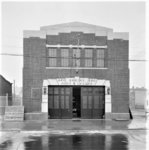
Engine 6 LICFD organized 685 Vernon Avenue former quarters Ladder 3 LICFD 1895
Engine 6 LICFD became Engine 60 FDNY 1898
Engine 60 new firehouse 3633 Vernon Avenue 1899
Engine 60 became Engine 160 1899
Engine 160 became Engine 260 1913
Engine 260 new firehouse 1115 37th Avenue 1939
Bridge Chemical Unit 61 organized 1115 37th Avenue at Engine 260 1939
Bridge Chemical Unit 61 moved 6418 Queens Boulevard at Engine 292 1944
Bridge Chemical Unit 61 moved 1040 47th Avenue at Engine 258 1950
Bridge Chemical Unit 61 disbanded 1957
Emergency Utility Unit 1 located 1115 37th Avenue at Engine 260 1942-1958
Searchlight 21 located 1115 37th Avenue at Engine 260 1972-1990
Foam Unit Queens organized 6418 Queens Boulevard at Engine 292 1965
Foam Unit Queens moved 1115 37th Avenue atg Engine 260 1972
Foam Unit Queens disbanded 1988
Foam 81 organized 1115 37th Avenue at Engine 260 1988
Foam 81 disbanded 1998
Foam 260 organized 1115 37th Avenue at Engine 260 1998
Foam 260 moved 3089 21st Street at Engine 262 1999
Foam 260 moved 1115 37th Avenue at Engine 260 2000

Last edited:



